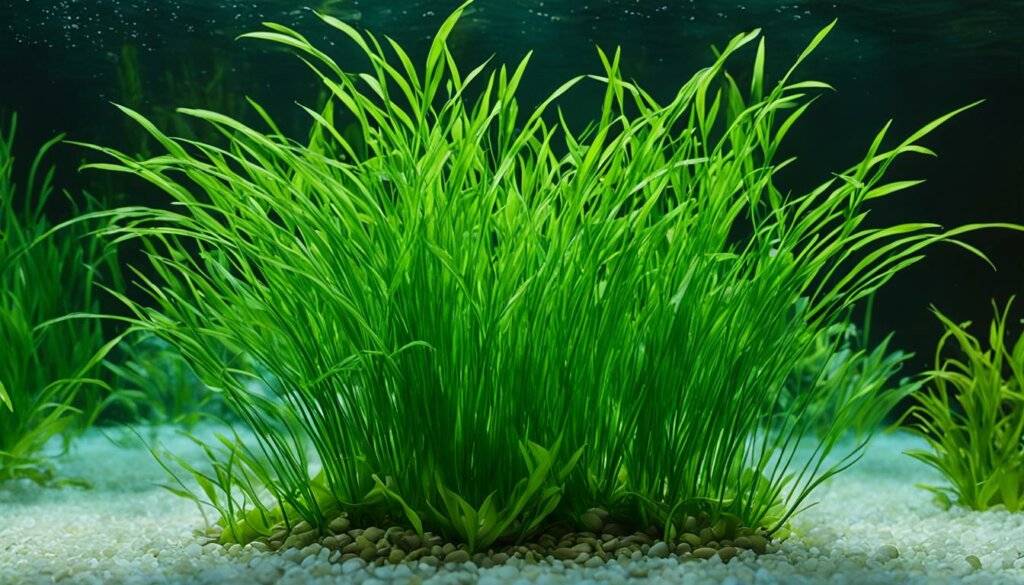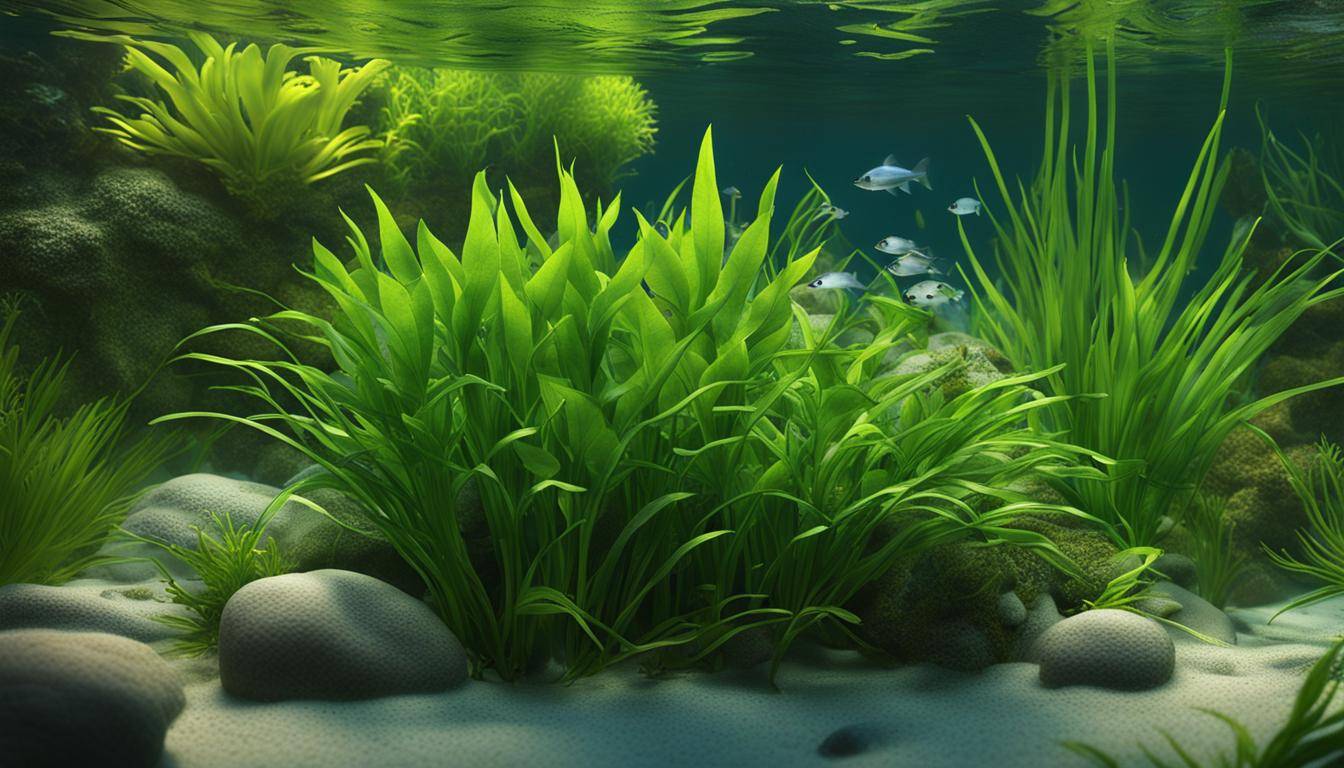You’ve spent hours making your dream aquarium. It’s a perfect home for your fish, with bright colors and clear water. But something feels off.
Looking down at the bottom, it’s too plain. It isn’t as lush as you wanted. Then, you remember the dwarf sagittaria. It’s known for turning tank bottoms into stunning gardens.
You go to your local fish shop to find it. Walking through, you see green plants moving in the water. At the plant section, you spot the dwarf sagittaria. It’s like a green carpet with fine leaves. You immediately know it’s what your tank needs.
You buy some and set it up in your aquarium. Carefully, you plant each stem into the bottom. Soon, the whole bottom is a green garden.
Over time, the dwarf sagittaria starts to grow fast. It spreads and makes more plants. Now, your tank’s bottom is a lush green area. Your fish play and hide in it, making it more lively.
You love how it looks now. The dwarf sagittaria has turned your tank into a beautiful place. You’re just happy sitting and watching your fish in their new, green home.
In the next sections, let’s learn more about dwarf sagittaria. We’ll talk about what it is, how to take care of it, and more. You’ll learn how to make your tank stunning with this wonderful aquarium plant. Let’s explore and make your tank a true underwater paradise!
What Is Dwarf Sagittaria?
Dwarf Sagittaria, or Sagittaria subulata, is a type of aquatic plant. It’s often used in both freshwater and brackish water. This makes it great for all kinds of aquariums. It spreads quickly through runners, which is helpful for building aquascapes. It’s not only pretty but also great for giving small fish places to hide and breed.
If you love aquascaping, you’ll see how special Dwarf Sagittaria is. It looks delicate and colorful. Plus, it spreads like a carpet, making your setup look full and interesting.
Do you want a green sea or a simple look? Dwarf Sagittaria can fit many styles. And, it’s so easy to care for. This makes it a top pick for both new and experienced fish keepers.
| Features | Dwarf Sagittaria | Other Aquatic Plants |
|---|---|---|
| Growth Pattern | Spreads rapidly through runners | Varies depending on species |
| Aquarium Compatibility | Freshwater and brackish water | Species-specific |
| Appearance | Vivid green leaves with rounded or acute tips | Varies depending on species |
| Functionality | Provides hiding and breeding areas for small inhabitants | Varies depending on species |
| Required Lighting | Medium to bright | Varies depending on species |
For aquascaping fans, Dwarf Sagittaria is key. It helps you make stunning aquarium landscapes. And it’s not hard to maintain. This plant adds beauty and life to your tank.
Benefits of Dwarf Sagittaria:
- Adds a touch of natural beauty to your aquarium
- Creates dense carpet-like cover through rapid spreading
- Provides hiding and breeding areas for small inhabitants
- Tolerates a wide range of water conditions
“Dwarf Sagittaria is the perfect aquatic plant for aquascaping enthusiasts who desire both visual appeal and functional benefits in their aquariums.”
Dwarf Sagittaria Facts
Dwarf Sagittaria, also known as Sagittaria subulata, is an intriguing aquatic plant. It’s part of the Alismataceae family. People commonly call it Needle Sagittaria, Floating Arrowhead, or Narrow-Leaved Arrowhead. It looks like a grass, bringing natural beauty to aquariums.
The plant has bright green leaves with pointy tips. This makes it look beautiful. It can grow underwater or partly above water. Underwater, the leaves are skinny and long.
Dwarf Sagittaria comes from the southeast U.S. and South America. It lives in places like marshes, coasts, and river areas. This plant is strong and can live in various settings in your aquarium.

-
Save
Habitat and Care Requirements
Dwarf Sagittaria is a tough little plant. It can live in many water conditions. These include both freshwater and slightly salty water. This makes it a great choice for different aquarium types.
It likes water that is a bit acid or a bit base. The pH should be between 6.0 and 7.5. It also does well with varying levels of light. This flexibility means it can fit into many aquariums.
For Dwarf Sagittaria to do its best, put it in a spot with lots of nutrients. A sandy or fine gravel bottom is perfect for its roots. Adding CO2 and plant food can also help it grow.
This plant spreads quickly thanks to its runners. This makes it cover the ground in your aquarium fast. To keep it tidy, trim it regularly.
Key Care Requirements for Dwarf Sagittaria:
- Water conditions: Slightly acidic to slightly alkaline, pH range of 6.0 to 7.5
- Lighting: Medium to bright
- Substrate: Nutrient-rich, sandy or fine gravel
- Propagation: Rapid through runners
- Pruning: Regularly to maintain appearance
To keep your Dwarf Sagittaria plant happy and healthy, set up its home right. Remember the right water, light, and soil. And don’t forget to trim it to keep it looking good.

-
Save
| Habitat Requirements | Care Requirements |
|---|---|
| Water conditions | Slightly acidic to slightly alkaline, pH range of 6.0 to 7.5 |
| Lighting | Medium to bright |
| Substrate | Nutrient-rich, sandy or fine gravel |
| Propagation | Rapid through runners |
| Pruning | Regularly to maintain appearance |
Buying and Acclimating Dwarf Sagittaria
It’s very important to buy Dwarf Sagittaria from a trusted source. This way, you get the right species and avoid mislabeling. Always ask questions, do your research, and make sure you pick healthy plants.
To add Dwarf Sagittaria to your tank, acclimate them slowly. First, adjust the water temperature in the bag to match your tank. Do this by letting the bag float in the tank. Then, slowly mix your tank water into the bag. Finally, place the plant in the tank. This method is key for the plant to thrive.
Buying Dwarf Sagittaria – Key Considerations:
- Choose trustworthy and reputable sources
- Inquire about the correct species
- Research the plant and its characteristics
- Opt for healthy specimens without preexisting conditions
Acclimating Dwarf Sagittaria – Step-by-Step Guide:
- Match the bag/container water temperature to the tank water
- Float the sealed bag in the tank for temperature adjustment
- Add small amounts of tank water to the bag over time
- Release the plant into the tank once acclimated
Buying and Acclimating Dwarf Sagittaria
| Considerations | Buying Dwarf Sagittaria | Acclimating Dwarf Sagittaria |
|---|---|---|
| Importance | Ensuring correct species and quality | Facilitating a smooth transition |
| Key Steps | 1. Choose trustworthy sources 2. Ask questions and research 3. Select healthy specimens |
1. Match temperature 2. Float bag for adjustment 3. Gradually add tank water 4. Release plant into tank |
| Benefits | Obtaining desired species Minimizing mislabeling risks |
Preventing shock and stress Promoting successful acclimation |
Conclusion
Dwarf Sagittaria is a great pick for your aquarium. It looks nice and quickly spreads out. This creates a thick cover on the bottom, which many people like. Taking good care of it with proper light, dirt, and water will help it grow well.
It works well in both the front and middle of your tank. No matter where you put it, it adds a lot of color and beauty. Its deep green leaves form a blanket that makes your tank look amazing.
To sum up, Dwarf Sagittaria is key for anyone who loves setting up fish tanks. It grows fast and turns your tank into a green paradise. Get one for yourself and see how it changes your aquarium into a vibrant home for your fish.
